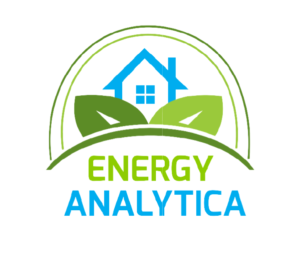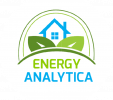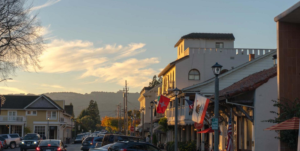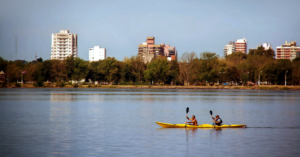Energy efficient design is an integral part of any building built in the state of California. All newly constructed building as well as addition and alteration projects are required to meet the minimum energy efficiency thresholds. Some cities and counties require construction projects to be designed and built with higher level of energy efficiency. Following is the code language for such high energy efficiency projects.
CALGreen Code Section A5.203.1: Energy efficiency.
Nonresidential, high-rise residential and hotel/ motel buildings that include lighting and/or mechanical systems shall comply with Sections A5.203.1.1 and A5.203.1.2. Newly constructed buildings and additions are included in the scope of these sections. Buildings permitted without lighting or mechanical systems shall comply with Section A5.203.1.1 but are not required to comply with Section A5.203.1.2.
CALGreen Code Section A5.203.1.1: Tier 1 and Tier 2 prerequisites.
To comply with Tier 1, ONE of the following efficiency measures is required for all applicable components of the building project. To comply with Tier 2, TWO of the following efficiency measures are required.
CALGreen Code Section A5.203.1.1.1: Outdoor lighting.
Newly installed outdoor lighting power shall be no greater than 90 percent of the Allowed Outdoor Lighting Power and general hardscape lighting within the scope of Title 24, Part 6, Section 140.7(b)1 shall have a color temperature no higher than 3000K. The Allowed Outdoor Lighting Power calculation is specified in Title 24, Part 6, Section 140.7, Requirements for Outdoor Lighting.
Exception: The color temperature requirement is not applicable to the applications identified in the Exceptions to Section 140.7(a) nor to the applications identified as “specific applications” in Section 140.7(b)2 and Table 140.7.
CALGreen Code Section A5.203.1.1.2: Service water heating in restaurants.
Newly constructed restaurants 8,000 square feet or greater and with service water heaters rated 75,000 Btu/h or greater shall install a solar water-heating system with a minimum solar savings fraction of 0.15.
Exceptions:
1. Buildings with a natural gas service water heater with a minimum of 95-percent thermal efficiency.
2.Buildings where greater than 75 percent of the total roof area has annual solar access that is less than 70 percent. Solar access is the ratio of solar insolation, including shade, to the solar insolation without shade. Shading from obstructions located on the roof or any other part of the building shall not be included in the determination of annual solar access.
CALGreen Code Section A5.203.1.1.3: Warehouse Dock Seal Doors.
Exterior loading dock doors that are adjacent to conditioned or indirectly conditioned spaces shall have dock seals or dock shelters installed at the time of permitting. This requirement shall apply to newly constructed buildings and to loading dock doors added to existing buildings.
CALGreen Code Section A5.203.1.1.4: Daylight Design Power Adjustments Factors (PAFs).
Daylighting devices shall be installed as specified in Title 24, Part 6, Section 140.3(d).
CALGreen Code Section A5.203.1.1.5: Exhaust Air Heat Recovery.
Heat recovery requirements based on ASHRAE 90.1 Section 6.5.6.1 are adapted and modified for California climate zones as described below.
1. Systems with minimum design outdoor air fraction of 80 percent or greater and supply air flow of 200 cfm or greater in climate zones 2, 9, 10, 11, 12, 13, 14, 15 shall have a heat recovery system.
2. Heat recovery systems required by this section shall result in a net sensible energy recovery ratio of at least 60 percent for both heating and cooling as tested using AHRI 1060-2014 or 1061-2014 and certified by AHRI. A 60 percent sensible energy recovery ratio shall mean a change in the dry-bulb of the outdoor air supply equal to 60 percent of the difference between the outdoor air and exhaust air dry-bulb at design conditions. Provisions shall be made to bypass or control the energy recovery system to permit air economizer operation as required by Title 24, Part 6, Section 140.4(e), Economizers.
Exceptions:
1. Systems serving spaces that are not cooled and that are heated to less than 60°F.
2. Where more than 60 percent of the outdoor air heating energy is provided from site-recovered energy.
3. Where the sum of the airflow rates exhausted and relieved within 20 feet of each other is less than 75 percent of the design outdoor airflow rate, excluding exhaust air that is:
1. Used for another energy recovery system;
2. Not allowed by ASHRAE Standard 170 for use in energy recovery systems with leakage potential; or
3. Of Class 4 as defined in ASHRAE Standard 62.1.
4. Systems expected to operate less than 20 hours per week.
CALGreen Code Section A5.203.1.2: Performance standard.
Comply with one of the advanced efficiency levels indicated below.
A5.203.1.2.1 Tier 1.
Buildings complying with the first level of advanced energy efficiency shall have an Energy Budget that is no greater than indicated below, depending on building type and the type of energy systems included in the building project. If the newly constructed building or addition does not include indoor lighting or mechanical systems, then no additional performance requirements above Title 24, Part 6 are required.
1. For nonresidential building projects that include indoor lighting or mechanical systems, but not both: No greater than 95 percent of the Title 24, Part 6, Energy Budget for the Standard Design Building as calculated by compliance software certified by the Energy Commission.
2. For nonresidential building projects that include indoor lighting and mechanical systems: No greater than 90 percent of the Title 24, Part 6 Energy Budget for the Standard Design Building as calculated by compliance software certified by the Energy Commission.
3. For high-rise residential and hotel/motel building projects: No greater than 95 percent of the Title 24, Part 6, Energy Budget for the Standard Design Building as calculated by compliance software certified by the Energy Commission.
A5.203.1.2.2 Tier 2.
Buildings complying with the second level of advanced energy efficiency shall have an Energy Budget that is no greater than indicated below, depending on the type of energy systems included in the building project. If the newly constructed building or addition does not include indoor lighting or mechanical systems, then no additional performance requirements above Title 24, Part 6 are required.
1. For nonresidential building projects that include indoor lighting or mechanical systems, but not both: No greater than 90 percent of the Title 24, Part 6, Energy Budget for the Standard Design Building as calculated by compliance software certified by the Energy Commission.
2. For nonresidential building projects that include indoor lighting and mechanical systems: No greater than 85 percent of the Title 24, Part 6, Energy Budget for the Standard Design Building as calculated by compliance software certified by the Energy Commission.
3. For high-rise residential and hotel/motel building projects: No greater than 90 percent of the Title 24, Part 6, Energy Budget for the Standard Design Building as calculated by compliance software certified by the Energy Commission.
Note: For Energy Budget calculations, high-rise residential and hotel/motel buildings are considered nonresidential buildings.
Intent:
The 2019 California Energy Code, CCR, Title 24, Part 6, sets the minimum energy efficiency standards for the vast majority of buildings subject to permitting under the Building Standards Code, including most commercial occupancies. Some local jurisdictions desire to adopt stricter energy efficiency standards than the statewide minimum; the intent of these measures is to encourage greater building performance beyond the requirements in the 2019 California Energy Code, CCR, Title 24, Part 6 by providing a model code framework for these jurisdictions.
Encouraging local “reach codes” supports California’s statewide energy policies. For example, the state 2008 Long Term Energy Efficiency Strategic Plan calls for zero net energy use in newly constructed commercial buildings by 2030, and these reach standards are meant to strive toward achievement of that goal.
Compliance Method:
Software used to calculate a building’s energy performance for compliance with Part 6 of the California Energy Code is also used for the purpose of documenting improvements via these voluntary measures. Compliance documents should be submitted with the construction documents in whatever format the enforcing agency requires for Part 6 energy code compliance.
Note: For guidance on the associated voluntary standards included in the tiers for each project, refer to each section’s guidelines in this part of this guide.
Enforcement:
Plan intake: The plan reviewer should confirm that the construction documents show compliance with energy or other documentation for Part 6 energy code compliance, as well as confirmation of associated voluntary measures (see note above).
On-site enforcement: The inspector should verify energy compliance documents against the installed features in the project, including windows, insulation, roofing, lighting, controls, etc., to make sure the installations comply. This is similar to what site inspectors or third-party verifiers do for Part 6 energy code compliance.
(Excerpted from ‘Guide to the 2019 California Green Building Standards Code Nonresidential’ – Chapter 5)




